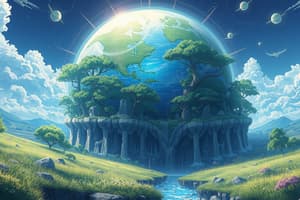Podcast
Questions and Answers
Why is the world green?
Why is the world green?
The world is green due to the presence of plants and photosynthetic organisms.
What parts are not green?
What parts are not green?
Deserts, oceans, and urban areas are examples of parts that are not green.
Is there less life in the deserts?
Is there less life in the deserts?
Yes, deserts typically have less biodiversity and fewer living organisms due to harsh environmental conditions.
Is there less life in the sea?
Is there less life in the sea?
What is living?
What is living?
Which organisms are included in the definition of living organisms?
Which organisms are included in the definition of living organisms?
What is sexual reproduction?
What is sexual reproduction?
What is a species?
What is a species?
Which of the following can reproduce to create hybrids?
Which of the following can reproduce to create hybrids?
What currently defines biodiversity?
What currently defines biodiversity?
How many species of bacteria are estimated to exist?
How many species of bacteria are estimated to exist?
What does species diversity measure?
What does species diversity measure?
Match the following tortoise species with their common names:
Match the following tortoise species with their common names:
What is the classification of the White rhinoceros?
What is the classification of the White rhinoceros?
How many subspecies does the Black rhinoceros have?
How many subspecies does the Black rhinoceros have?
What tropical rhinoceros species is known for having only one horn?
What tropical rhinoceros species is known for having only one horn?
Flashcards are hidden until you start studying
Study Notes
The Biosphere
- The biosphere encompasses all living organisms on Earth, including plants, animals, and microorganisms.
- It can be visualized as a "skin" covering the Earth, interacting with its other spheres: lithosphere (land), hydrosphere (water), and atmosphere (air).
Why is the World Green?
- The green color of the Earth is primarily due to the presence of plants, which contain chlorophyll, a pigment essential for photosynthesis.
- Areas that are not green indicate the absence of significant plant life, such as deserts and oceans.
Living Organisms
- Living organisms are characterized by their ability to reproduce, either sexually or asexually.
- Viruses are not considered living organisms because they cannot reproduce independently and require a living host cell to replicate.
Sexual and Asexual Reproduction
- Sexual reproduction involves the combination of genetic material from two different individuals, resulting in offspring with unique genetic combinations.
- Asexual reproduction does not involve the mixing of genetic material and offspring are genetically identical to the parent.
Species
- A species is a group of organisms that can interbreed and produce fertile offspring.
- Organisms belonging to different species can produce hybrids, but these hybrids are often sterile, preventing the exchange of genetic material between species.
Naming Species
- The scientific name of a species is composed of two parts: the genus name and the specific epithet.
- Example: Acinonyx jubatus (cheetah), where Acinonyx is the genus and jubatus is the specific epithet.
Classification
- The classification of organisms follows a hierarchical system, starting from the broadest category (kingdom) and becoming more specific down to the species level.
- The hierarchical levels are: Kingdom, Phylum, Class, Order, Family, Genus, Species.
Biodiversity
- Biodiversity refers to the variety of life on Earth, measured in terms of the number of species (species diversity) or other taxonomic groups.
- Biodiversity can be measured at local, regional, and global scales.
Species Diversity
- Local diversity refers to the number of species found in a specific area, such as a forest or lake.
- Regional diversity encompasses the number of species within a larger geographic region.
- Global diversity represents the total number of species on Earth.
Example of Local Diversity: Tortoises
- South Africa is home to a diverse range of tortoise species, including:
- Chersina angulata (Bowsprit Tortoise)
- Geochelone pardalis (Leopard Tortoise)
- Homopus aerolatus (Parrot-Beaked Cape Tortoise)
- Homopus boulengeri (Boulenger's Cape Tortoise)
- Homopus femoralis (Karroo Cape Tortoise)
- Homopus signatus (Speckled Cape Tortoise)
- Homopus bergeri (Berger's Cape Tortoise)
- Kinixys belliana (Bell's Hinge-Backed Tortoise)
- Kinixys lobatsiana (Lobatse Hingeback Tortoise)
- Kinixys natalensis (Natal Hinge-Backed Tortoise)
- Kinixys spekii (Speke's Hingeback Tortoise)
- Psammobates geometricus (Geometric Tortoise)
- Psammobates oculifer (Serrated Star Tortoise)
- Psammobates tentorius (African Tent Tortoise)
Example of Global Diversity: Rhinos
- The world's rhino species are classified within different genera:
- Genus Ceratotherium (White rhinoceros):
- Ceratotherium simum simum (Southern white rhinoceros)
- Ceratotherium simum cottoni (Northern white rhinoceros)
- Genus Diceros (Black rhinoceros):
- Diceros bicornis bicornis (Drier parts of southern Africa)
- Diceros bicornis minor (Wetter, eastern parts of southern Africa)
- Diceros bicornis chobiensis (Botswana, Caprivi, western Zambia, eastern Angola)
- Diceros bicornis michaeli (Kenya, southern Somalia)
- Diceros bicornis ladoensis (Uganda, southern Sudan)
- Diceros bicornis brucii (Ethiopia, eastern Sudan)
- Diceros bicornis longpipes (Western Sudan, Chad, Central African Republic, eastern Nigeria)
- Genus Rhinoceros (One-horned rhinoceros):
- Rhinoceros unicornis (Indian rhinoceros)
- Rhinoceros sondaicus (Javan rhinoceros)
- Genus Dicerorhinus (Two-horned rhinoceros):
- Dicerorhinus sumatrensis (Sumatran rhinoceros):
- Dicerorhinus sumatrensis lasiotus (Burma)
- Dicerorhinus sumatrensis sumatrensis (Thailand, Malaya)
- Dicerorhinus sumatrensis harrissoni (Borneo)
Relationship between Size and Diversity
- There is a strong correlation between an organism's size and its species diversity: the smaller the organism, the greater its diversity.
- Insects represent the most diverse group of organisms, followed by plants.
- Larger animals are comparatively less diverse.
Challenges in Defining Bacterial Diversity
- Defining species for bacteria is difficult because their reproduction is not primarily sexual, making it challenging to define clear boundaries between species.
Studying That Suits You
Use AI to generate personalized quizzes and flashcards to suit your learning preferences.




